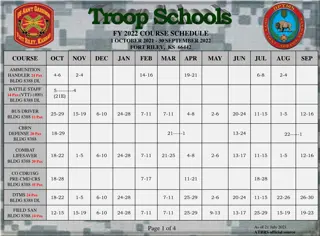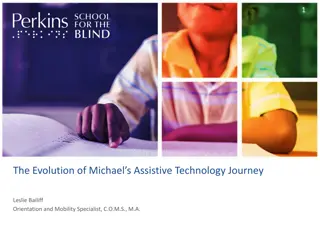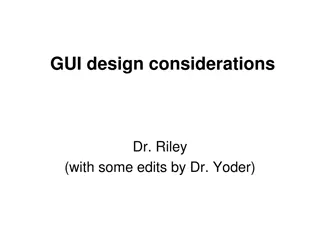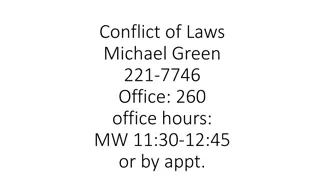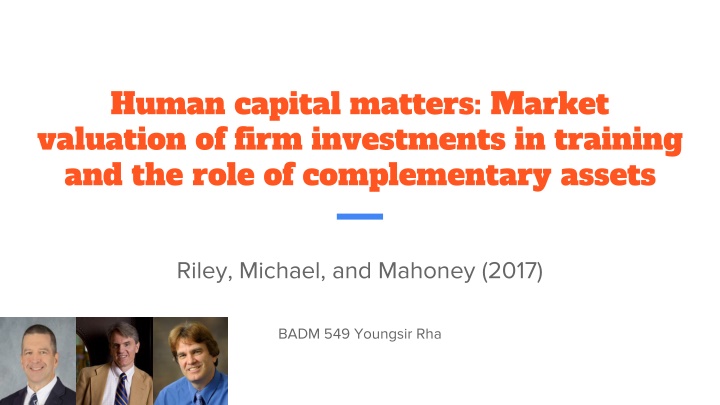
Market Valuation of Firm Investments in Human Capital Training
Explore the financial benefits of investing in human capital training for firms and the role of complementary assets in maximizing returns. Research findings indicate positive stock market reactions to effective human capital investments when supported by R&D, physical capital, and advertising investments. Dive into the literature review on the importance of firm-specific human capital for sustainable competitive advantage.
Download Presentation

Please find below an Image/Link to download the presentation.
The content on the website is provided AS IS for your information and personal use only. It may not be sold, licensed, or shared on other websites without obtaining consent from the author. If you encounter any issues during the download, it is possible that the publisher has removed the file from their server.
You are allowed to download the files provided on this website for personal or commercial use, subject to the condition that they are used lawfully. All files are the property of their respective owners.
The content on the website is provided AS IS for your information and personal use only. It may not be sold, licensed, or shared on other websites without obtaining consent from the author.
E N D
Presentation Transcript
Human capital matters: Market valuation of firm investments in training and the role of complementary assets Riley, Michael, and Mahoney (2017) BADM 549 Youngsir Rha
Summary Research questions Q1: Can investments in general training be beneficial for firms financially? Q2: What (firm-level) factors influence the variance of the returns? Methodology Q1: Event study. An event is the release of information that firms were awarded with training top125 . Analyzed their abnormal stock market returns. Q2: Regression analyses to test hypotheses regarding complementary relationships Results Signal of effective investments in human capital training leads to positive stock price reaction Human capital investments are more impactful when there are complementary investments in R&D, physical capital, and advertising investments Human capital matters!
Literature Review Resource-based View Resources that are valuable, inimitable, nonsubstitutable, and organizationally embedded (VRIO) can result in a firm s superior financial performance. Investments in firm-specific human capital are potential sources of sustainable competitive advantage because they are intangible, tacit, and inimitable.
General Training vs Firm-specific Training Traditional views General Training (GT) provides skills that are also useful in other firms (competitors). With GT, employees' employability increases because other firms can also capture some of the returns from training without making investments themselves. I.e., a competitor can free ride off of the investments of the firm carrying out GT. Regarding firm-specific training, the firm is expected to gain at least some of the economic returns from training that increases productivity when the human capital is firm-specific (Coff, 1997; Harris & Helfat, 1997; Hashimoto, 1981). RBV suggests that firms are willing to invest in firm-specific human capital because these intangible investments' tacit, complex, and causally ambiguous nature makes imitability difficult (Lippman & Rumelt, 1982; Rumelt, 1984). Prior Lit: Only firm-specific human capital engenders resources, which leads to higher financial performance.
Literature Review Becker (1964) Premise: competitive labor market, poached worker can immediately and painlessly start working, and yield full value, in a job commensurate with his training. This implies that transactions costs are negligible, potential recruiting firm has full information regarding training in other firms, and there are no costs related to such absence of information. Human capital investments in employee training and education can have positive economic value because they develop and nurture employees' knowledge and skills, thereby improving their productivity. Wage rates, which are determined by marginal productivity in other firms, would rise by the same amount as the marginal product, and the firms providing the training cannot capture any of the return. Meanwhile, the competitors can hire workers at a higher wage because they don t bear the cost of training. They can attract a worker with such training by outbidding the firm which trained him Firms that provide GT will lose their trained workers!
What happens in a not perfectly competitive labor market? Coff et al. Identified market frictions that may allow for increase in financial performance even when the training is general. Supply-side Demand-side Employee s willingness to move is weak because they are bounded by market frictions. Job search is costly and time-consuming. Training is a signal to employees that firms are committed to them. It is difficult to measure the value of the training program, Employee productivity may not remain the same in the new firm Uncertain which part of training is useful for a new firm Instantaneous adjustment suggested by Becker is not certain due to delay in mobility The high cost of moving and the uncertain benefit of training to the hiring firm calls for significant market friction.
Labor market frictions can also create a competitive advantage through training and other HC investments. Departure from extant literature Previous studies looked at the non-financial implications of HC investment and training. This paper investigates the financial performance implications.
Hypothesis for financial implication of HC investment Due to employees adjustment costs, the firm that provides general training may be able to retain generally trained employees while paying them less than their full marginal product and keeping the remaining economic returns from training. As for firm-specific training, the firm will gain some economic returns from training via increased productivity. Also, RBV suggests that firm-specific, tacit, and ambiguous intangible investments make them hard to imitate. Thus, investments in both (effective) general training and firm-specific training have the potential to yield a sustainable competitive advantage. One measure of that advantage is the positive stock price reaction to new information demonstrating the magnitude and efficacy of those investments. H1: A signal of firms effective investments in human capital leads to a positive stock price reaction.
Complementarities Complementary activities: doing more of a given activity increases the marginal profitability of each of the other activities. RBV: higher financial performance can be achieved by investing in complementary resources Previous studies show that HC and organizational resources are complementary. Amit and Schoemaker (1993): Strategic assets are firm-specific, intangible, and tacit resources and capabilities subject to market frictions that generate organizational rents. It is also complementary to other strategic assets of the firm. This paper tests this hypothesis to find the complementaries to HC investment
Hypotheses for complementaries H2: The higher the firms R&D intensity, the greater the positive stock price reaction to the signal of effective investments in human capital. H3: The higher the firms physical capital intensity, the lesser the positive stock price reaction to the signal of effective investments in human capital. H4: The higher the interaction of R&D intensity and physical capital intensity, the greater the positive stock price reaction to the signal of effective investments in human capital. H5: The higher the firm s advertising intensity, the greater the positive stock price reaction to the signal of effective investments in human capital.
Methods Event study for H1 Sample Public firms receiving the awards during the time period of 2005 2008 (219 events involving 99 business units of 95 parent corporations) Measurements DV: cumulative abnormal returns IV(measured in the year before the award): - R&D intensity R&D investment divided by sales - Physical capital intensity physical capital investment divided by sales - Advertising intensity advertising expenditures divided by sales Controls: firm size, whether the award was for the entire corporation or a division, whether the firm won an award in the previous year and industry Event: the announcement that a firm has received a Training Top 125 award. This event (information) is a signal that can lead to significant abnormal returns. Regression analysis for H2-H5 Regression analyses to test hypotheses regarding complementary relationships between firm-level factors and human capital investments Analyze abnormal returns to explain variance using measures of complementary assets
Conclusion Signals about effective investments in human capital training lead to positive stock price reactions. Human capital investments are more impactful when there are complementary investments in R&D, physical capital, and advertising investments Human capital matters! Contrary to the conventional wisdom, general training and firm-specific training have positive financial implications for the providing firm.



